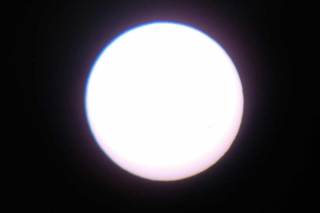I haven’t stared at the sun for any length of time in the past couple of years; otherwise the news that there are now two sunspots visible for the first time in, well, a couple of years, wouldn’t have surprised me so much. Sunspot activity follows a 22-year cycle, from maximum to minimum, then a polarity reversal, then maximum and minimum again. So every 11 years the visible cycle repeats, and we have either an active sun or a quiet sun. And since not too many amateur astronomers have the equipment to measure the polarity of a sunspot, for all intents and purposes, the 11-year interval between minimums is the accepted “solar cycle.”
The current minimum, stretching from 2008 to at least September 2009, is apparently the deepest solar minimum in almost a century. Now that solar activity might indeed be picking back up,* maybe I’ll spend some time modifying my solar filter to fit my current rig (the TV-60), and see if I can’t improve on the featureless, not-quite-round blob that you see below, which was my last session of solar observing, March 11, 2005, from Venus, Florida. Unfortunately, I hadn’t (and still haven’t) spent much time figuring out the parameters of photographing the sun, so it looks pretty featureless. But I assure you, it is indeed the sun:
If the sun’s activity is indeed picking up, maybe I’ll have some better pictures to show you soon. But let’s not hold our breath: they’ve been wrong about declaring the end of the solar minimum before. Here’s an article from January 2008 announcing with great anticipation the end of the solar minimum. Whoops!
By the way, satellites, astronauts, GPS devices, airline flight crews, and many other parties (even plain old consumers of household electricity like you and me!) can be greatly affected by solar storms, and aren’t really in a hurry for the sun to kick back into active mode. They might not have read this story, though, which reports how the Earth can be hit with intense solar winds even when it’s in “quiet” mode. Or this website, which details how quickly the “quiet” sun can flare up. If you’re worried about such things (and some meteorologists are), you might want to check the space weather in addition to our local weather…







